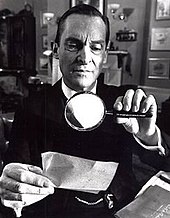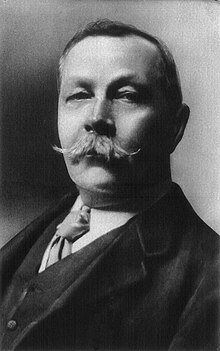Tuesday, 17 October 2017
Legacy
"Elementary, my dear Watson"
The phrase "Elementary, my dear Watson" is never uttered by Holmes in the sixty stories written by Conan Doyle. He often observes that his conclusions are "elementary", however, and occasionally calls Watson "my dear Watson". One of the nearest approximations of the phrase appears in "The Adventure of the Crooked Man" when Holmes explains a deduction: "'Excellent!' I cried. 'Elementary,' said he."[68][69]
William Gillette is widely considered to have originated the phrase with the formulation, "Oh, this is elementary, my dear fellow", allegedly in his 1899 play Sherlock Holmes. However, the script was revised numerous times over the course of some three decades of revivals and publications, and the phrase is present in some versions of the script, but not others.
The exact phrase, as well as close variants, can be seen in newspaper and journal articles as early as 1909; there is some indication that it was clichéd even then.[70] The phrase "Elementary, my dear fellow, quite elementary" appears in P. G. Wodehouse's novel, Psmith in the City (1909–1910),[69] and "Elementary, my dear Watson, elementary" in his 1915 novelPsmith, Journalist (neither spoken by Holmes).[71] The exact phrase "Elementary, my dear Watson" is used by protagonist Tom Beresford in Agatha Christie's 1922 novel The Secret Adversary. It also appears at the end of the 1929 film The Return of Sherlock Holmes, the first Holmes sound film.[68] The phrase became familiar with the American public in part due to its use inThe New Adventures of Sherlock Holmes radio series, broadcast from 1939 to 1947.
The Adventures of Sherlock Holmes
| "A Scandal in Bohemia" | July 1891 | The King of Bohemia engages Holmes to recover an indiscreet photograph showing him with the renowned beauty, adventuress and opera singer Irene Adler—the revelation of which would derail his marriage to a daughter of the King of Scandinavia. In disguise, Holmes witnesses Adler marry the man she truly loves, then by means of an elaborate stratagem discovers the photograph's hiding place. But when Holmes and the king return to retrieve the photo, they find Adler has fled the country with it, leaving behind a letter for Holmes and a portrait of herself for the King. The king allows Holmes to retain the portrait as a souvenir. | [10][11] |
|---|---|---|---|
| "The Red-Headed League" | August 1891 | Jabez Wilson, a pawnbroker, consults Holmes about a job he gained only because of his red hair. The job took him away from his shop for a short period each afternoon, and involved him copying the Encyclopædia Britannica. After eight weeks, he was informed that the job had suddenly finished. Holmes visits the pawnbroker's shop, and after some investigation contacts a police inspector and the manager of a nearby bank. Along with Watson, they hide in the bank vault, and catch two thieves, who had dug a tunnel from the shop during the hours that Wilson was out each afternoon. | [12] |
| "A Case of Identity" | September 1891 | Against the wishes of her stepfather, Miss Mary Sutherland has become engaged to Hosmer Angel. On the morning of their wedding Hosmer elicits a promise that Mary will remain faithful to him "even if something quite unforeseen" occurs, then mysteriously disappears on the way to the church. Holmes deduces that Hosmer was Mary's stepfather in disguise, the charade a bid to condemn his stepdaughter to spinsterhood and ensure his continued access to her inheritance. Holmes does not reveal the truth to Mary because "There is danger for him who taketh the tiger cub, and danger also for whoso snatches a delusion from a woman"; he had already advised her to put the matter behind her, though she responded that Hosmer "shall find me ready when he comes back." | [13] |
| "The Boscombe Valley Mystery" | October 1891 | Inspector Lestrade asks for Holmes's help after Charles McCarthy is murdered, and his son, James, is implicated. McCarthy, and another local landowner, John Turner, are both Australian expatriates, and Lestrade was originally engaged by Turner's daughter, Alice, who believes James is innocent. Holmes interviews James, and then inspects the scene of the murder, deducing a third man was present. Realising Holmes has solved the case, Turner confesses to the crime, revealing that McCarthy was blackmailing him due to Turner's criminal past. Holmes does not reveal the crime, but secures James's release because of the presence of a third person at the crime scene. | [14] |
| "The Five Orange Pips" | November 1891 | John Openshaw tells Holmes about two strange deaths in his family. In 1883, his uncle died two months after receiving a letter from India, inscribed "K.K.K." with five orange pips enclosed. In 1885, Openshaw's father received a similar letter, and died three days afterwards. Openshaw recently received a similar letter and asks for advice. Holmes tells Openshaw to do as the letter asks and leave a diary page, which Holmes deduces is connected to the Ku Klux Klan, on the garden sundial. Openshaw is killed before he can do so, but Holmes discovers the killers have been travelling on a sailing ship, and sends the captain a letter with five orange pips. The ship is lost at sea. | [15] |
| "The Man with the Twisted Lip" | December 1891 | Neville St. Clair, a respectable businessman, has disappeared and his wife claims she saw him at the upper window of an opium den. When she entered the room, she only found a beggar. St. Clair's clothes are later found in the room, and his coat, laden with coins, in the River Thames outside the window. The beggar is arrested for murder, but a few days later St. Clair's wife receives a letter from her husband. Holmes considers, and washes the beggar to discover that is actually St. Clair, who confesses that he has been leading a double life as a beggar as the income is so large, but promises to stop begging if Holmes will keep his secret from his wife. | [16] |
| "The Adventure of the Blue Carbuncle" | January 1892 | A "Blue Carbuncle" is stolen from a hotel suite, and a former felon is soon arrested. However, an acquaintance of Holmes discovers the carbuncle in the throat of a Christmas goose. Holmes traces the owner of the goose, but soon determines that he was not the thief by offering him a replacement goose. The detective continues his search, first to an inn and then a dealer in Covent Garden. The dealer refuses to provide Holmes with information about the source of the goose, but Holmes observes another man trying to find the same information, and confronts him. The man, the head attendant at the hotel, confesses to his crime. Holmes allows him to remain free, arguing that prison could make him a hardened criminal later. | [17] |
| "The Adventure of the Speckled Band" | February 1892 | Helen Stoner worries her stepfather may be trying to kill her after he contrives to move her to the bedroom where her sister had died two years earlier, shortly before her wedding. Stoner is herself now engaged, and Holmes learns that her stepfather's annuity (from the estate of his wife—Stoner's mother) would be greatly reduced if either sister married. During a late-night investigation of the bedroom, Holmes and Watson discover a dummy bell-pull near a ventilator. As they lie in wait a whistle sounds, then a snake appears through the ventilator. Holmes attacks the snake with his riding crop; it retreats to the next room, where it attacks and kills Stoner's stepfather. | [18] |
| "The Adventure of the Engineer's Thumb" | March 1892 | An engineer, Victor Hatherley, attends Dr Watson's surgery after his thumb is chopped off, and recounts his tale to Watson and Holmes. Hatherley had been hired for 50 guineas to repair a machine he was told compressedFuller's earth into bricks. Hatherley was told to keep the job confidential, and was transported to the job in a carriage with frosted glass, to keep the location secret. He was shown the press, but on closer inspection discovered a "crust of metallic deposit" on the press, and he suspected it was not being used for compressing earth. He confronted his employer, who attacked him, and during his escape his thumb is chopped off. Holmes deduces that the press is being used to produce counterfeit coins, and works out its location. However, when they arrive, the house is on fire, and the criminals have escaped. | [19] |
| "The Adventure of the Noble Bachelor" | April 1892 | Lord Robert St. Simon's new American bride, Hatty Doran, has disappeared almost immediately after the wedding. The servants had prevented an old love interest of his from forcing her way into the wedding breakfast, Hatty had been seen in whispered conversation with her maid, and Inspector Lestrade arrives with the news that Hatty's wedding dress and ring have been found floating in the Serpentine. Holmes quickly solves the mystery, locating Hatty at a hotel with a mysterious, "common-looking" man who had picked up her dropped bouquet after the ceremony. The man turns out to be Hatty's husband Frank, whom she had thought dead in America, and who had managed to locate her only moments before she was to marry Lord St. Simon. Frank and Hatty had just determined to go to Lord St. Simon in order to explain the situation when Holmes found them. | [20] |
| "The Adventure of the Beryl Coronet" | May 1892 | A banker asks Holmes to investigate after a "Beryl Coronet" entrusted to him is damaged at his home. Awakened by noise, he had found his son, Arthur, holding the damaged coronet. Arthur refuses to speak, neither admitting guilt nor explaining himself. Footprints in the snow outside the house tell Holmes that the banker's niece had conspired with a blackguard to steal the coronet; Arthur had discovered the crime in progress and the coronet had been damaged during his struggle to prevent it. He had refused to tell his father the truth of the crime because of his love for his cousin. | [21] |
| "The Adventure of the Copper Beeches" | June 1892 | Violet Hunter consults Holmes after being offered a governess job subject to a number of unusual conditions, including cutting her hair short. The wage is extremely high, £120, and she decides to accept the job, though Holmes tells her to contact him if she needs to. After a number of strange occurrences, including the discovery of a sealed-off wing of the house, she does so. Holmes discovers that someone had been kept prisoner in the wing, but when Holmes, Watson and Hunter enter, it is empty. They are accused of freeing the prisoner, who was the daughter of Hunter's employer, who sets his dog on them, though it attacks him instead. It is revealed that Hunter had been hired to impersonate her employer's daughter so that her fiancé would believe she was no longer interested in seeing him, but the daughter had escaped and the pair later married. |
Short story collections
| Mysteries and Adventures | 1890 | Scott | Mysteries |
|---|---|---|---|
| The Captain of the Polestar and Other Tales | 1890 | Longmans, Green | – |
| The Adventures of Sherlock Holmes | 1892 | George Newnes | Sherlock Holmes |
| The Gully of Bluemansdyke | 1893 | Scott | Mysteries |
| The Memoirs of Sherlock Holmes | 1894 | George Newnes | Sherlock Holmes |
| Round the Red Lamp: Being Facts and Fancies of Medical Life | 1894 | Methuen | – |
| The Exploits of Brigadier Gerard | 1896 | George Newnes | Brigadier Gerard |
| The Green Flag and Other Stories of War and Sport | 1900 | Smith, Elder & Co. | – |
| The Adventures of Gerard | 1903 | George Newnes | Brigadier Gerard |
| The Return of Sherlock Holmes | 1905 | George Newnes | Sherlock Holmes |
| Round the Fire Stories | 1908 | Smith, Elder & Co. | – |
| The Last Galley | 1911 | Smith, Elder & Co. | – |
| His Last Bow | 1917 | John Murray | Sherlock Holmes |
| Danger! and Other Stories | 1918 | John Murray | – |
| Three of Them | 1923 | John Murray | – |
| The Case-Book of Sherlock Holmes | 1927 | John Murray | Sherlock Holmes |
Adaptation in media
Guinness World Records has listed Holmes as the "most portrayed movie character",[1] with more than 70 actors playing the part in over 200 films. His first screen appearance was in the 1900 Mutoscope film, Sherlock Holmes Baffled.[90] The detective has appeared in many foreign-language versions, including a Russian miniseries broadcast in November 2013.[91]
William Gillette's 1899 play Sherlock Holmes, or The Strange Case of Miss Faulkner was a synthesis of four Conan Doyle stories: "A Scandal in Bohemia", "The Final Problem", "The Adventure of the Copper Beeches", and A Study in Scarlet. In addition to its popularity, the play is significant because it, rather than the original stories, introduced the key visual qualities commonly associated with Holmes today: his deerstalker hat and calabash pipe. It also formed the basis for the Gillette's 1916 film, Sherlock Holmes. In his lifetime, Gillette performed as Holmes some 1,300 times. In the early 1900s, H. A. Saintsbury took over the role from Gillette for a tour of the play. Between this play and Conan Doyle's own stage adaptation of "The Adventure of the Speckled Band", Saintsbury portrayed Holmes over 1,000 times.[92]
Basil Rathbone played Holmes and Nigel Bruce played Watson in fourteen U.S. films (two for 20th Century Fox and a dozen forUniversal Pictures) from 1939 to 1946, and in The New Adventures of Sherlock Holmes on the Mutual radio network from 1939 to 1946 (before the role of Holmes passed to Tom Conway). While the Fox films were period pieces, the Universal films were distinctive for abandoning Victorian Britain and moving to a then-contemporary setting in which Holmes occasionally battled Nazis.
The 1984–1985 Italian/Japanese anime series Sherlock Hound adapted the Holmes stories for children, with its characters being anthropomorphic dogs. The series was co-directed by Hayao Miyazaki.[93]
Between 1979 and 1986, Soviet television produced a series of five television films, The Adventures of Sherlock Holmes and Dr. Watson.[94] The series were split into eleven episodes and starred Vasily Livanov as Holmes and Vitaly Solomin as Watson. Livanov was appointed an Honorary Member of the Order of the British Empire[95] for a performance ambassador Anthony Brenton described as "one of the best I've ever seen".[94]

Jeremy Brett as Holmes in the Granada series
Jeremy Brett is considered the definitive Holmes by critic Julian Wolfreys.[96] Brett played the detective in four series of Sherlock Holmes for Britain's Granada Television from 1984 to 1994 and appeared as Holmes on stage. Watson was played by David Burkeand Edward Hardwicke in the series.
Bert Coules penned The Further Adventures of Sherlock Holmes[97] starring Clive Merrison as Holmes and Michael Williams/Andrew Sachs as Watson,[98] based on throwaway references in Doyle's short stories and novels.[97] He also produced original scripts for this series, which was also issued on CD.[99] Coules had previously dramatised the entire Holmes canon for Radio Four.[97][100]
The 2009 film Sherlock Holmes, which earned Robert Downey Jr. a Golden Globe Award for his portrayal of Holmes and which co-starred Jude Law as Watson, focuses on Holmes's antisocial personality.[101] Downey and Law returned for a 2011 sequel, Sherlock Holmes: A Game of Shadows. As of May 2016, a script for a third film is ready and the aim is to begin shooting before the end of the year; further sequels are acknowledged as possible.[102]
Benedict Cumberbatch plays a modern version of the detective (with Martin Freeman as John Watson) in the BBC One TV series Sherlock, which premiered on 25 July 2010. In the series, created by Mark Gatiss and Steven Moffat, the stories' original Victorian setting is replaced by present-day London. Cumberbatch's Holmes uses modern technology (including texting and blogging) to help solve crimes.[103] Similarly, on 27 September 2012, Elementarypremiered on CBS. Set in contemporary New York, the series features Jonny Lee Miller as Sherlock Holmes and Lucy Liu as a female Dr. Joan Watson.
The 2015 film Mr. Holmes starred Ian McKellen as a retired Sherlock Holmes living in Sussex, in 1947, who grapples with an unsolved case involving a beautiful woman.[104] The film is based on Mitch Cullin's 2005 novel A Slight Trick of the Mind.
Holmes has also appeared in video games, including the Adventures of Sherlock Holmes series of seven titles. The detective is based on Jeremy Brett's portrayal, with the series's plot independent of the Conan Doyle stories.
Most popular novels
Short biography
Sir Arthur Ignatius Conan Doyle (22 May 1859 – 7 July 1930) was a British writer best known for hisdetective fiction featuring the character Sherlock Holmes. Originally a physician, in 1887 he published A Study in Scarlet, the first of four novels about Holmes and Dr. Watson. In addition, Doyle wrote over fifty short stories featuring the famous detective. The Sherlock Holmes stories are generally considered milestones in the field of crime fiction.
Doyle was a prolific writer; his non-Sherlockian works include fantasy and science fiction stories about Professor Challenger and humorous stories about the Napoleonic soldier Brigadier Gerard, as well as plays, romances, poetry, non-fiction and historical novels. One of Doyle's early short stories, "J. Habakuk Jephson's Statement", helped to populare the mystery of Mary Celeste.
Subscribe to:
Comments (Atom)






